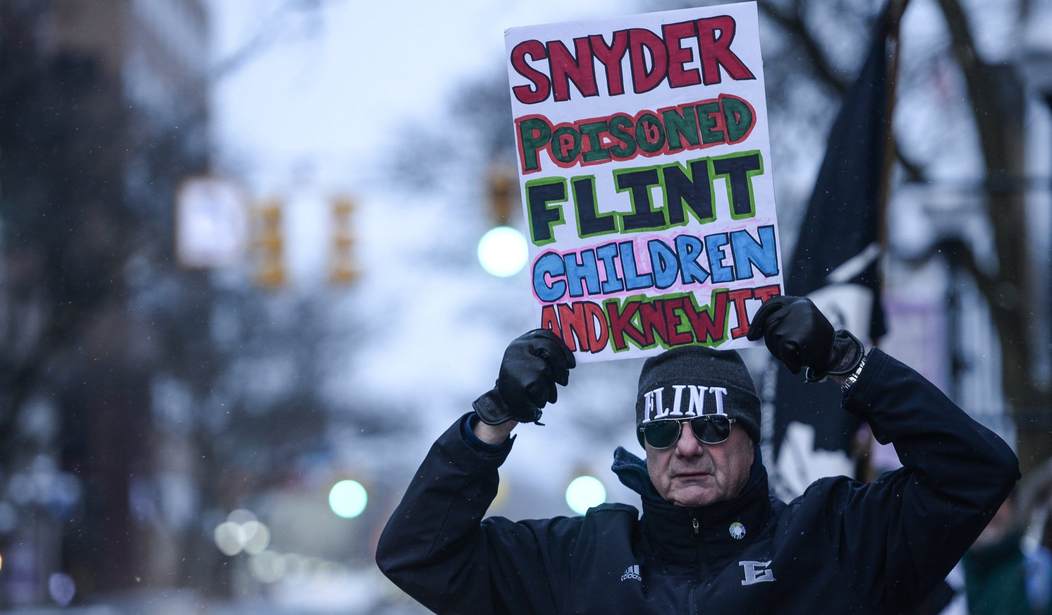For years, the people of Flint, Mich., and state inspectors were waving red flags that the water people were drinking was not safe. Their warnings were ignored or covered up. So people in Flint were cooking with and drinking water that contained too much lead.
There are many layers of responsibility for the poisoning of the city’s municipal water supply.
Sen. Bernie Sanders (I-Vt.) wants Michigan Gov. Rick Snyder’s (R) resignation. Hillary Clinton told a Martin Luther King event audience in Charleston, S.C.,“We would be outraged if this happened to white kids, and we should be outraged that it’s happening right now to black kids.”
Although he failed to remind Clinton that white kids live in Flint, too, Snyder did accuse her of “politicizing” the problems of the people in that community.
But Snyder apologized to Flint residents in his State of the State address Tuesday, and said they deserved better.
Snyder didn’t fall on his sword alone. He also blamed the Michigan Department of Environmental Quality and the U.S. Environmental Protection Agency for their lack of response to the first alarms of bad water in one of the state’s most economically depressed cities.
“Government failed you at the federal, state and local level,” Snyder said. “We need to make sure this never happens again in any Michigan city.”
With his promise, Snyder may have inadvertently waved the largest red flag of the Flint water crisis that has claimed an international spotlight.
There is no guarantee that what happened in Flint will not happen in any other major American community. In fact, Joseph Kane, a researcher at the Brookings Institution’s Metropolitan Policy Program, told PJM it could, and probably will, happen anywhere, anytime.
It isn’t a question of black people being ignored, as Hillary Clinton suggested, while white people would have their problems addressed. It is a matter of money. Affluent communities that can afford to repair and reline their water pipes don’t have problems like what Flint is facing.
Aside from bureaucratic malfeasance, Flint’s water problems can be blamed on aging infrastructure. Basically, corroded pipes.
True, if the proper chemicals had been administered to the water when state officials switched the town from the Detroit water system to the Flint River, there would not have been a problem.
The chemicals would have coated the water pipes and prevented the lead from leaking into the water system. But the fact remains, the lead is a problem because Flint’s water pipes have reached the end of their life expectancy.
Here’s the kicker: your town could be next.
“There are certain fundamental infrastructure challenges that Flint is currently enduring that are very widespread throughout the country,” said Kane, “particularly in older, industrialized cities in the Midwest.”
Doubling the impact of sagging infrastructure in Rust Belt America is the fact that the communities where the need is most urgent are lacking the tax base to pay for proper repair and replacement.
All is not lost, Kane said. Some politicians are trying to ensure their constituents will be able to depend on the most basic need of human survival: water.
Kane pointed to Pennsylvania, where the state government has created the PENNVEST program that has provided close to $8 billion in low-interest loans for drinking water, wastewater and stormwater system improvements since 1988.
Chicago officials are pushing a $1.4 billion plan for water infrastructure system upgrades.
Kane said Baltimore officials are working to replace and reline aging pipes, along with improving municipal water treatment plants.
In Columbus, Ohio, officials are working on an integrated blueprint plan to address its stormwater, sewer system, and green infrastructure.
While his counterpart in Michigan was probably putting the finishing touches on his State of the State apology; Minnesota Gov. Mark Dayton announced a $219.7 million plan Jan. 14 to modernize the state’s aging wastewater and drinking infrastructure, along with another $52.7 million that would be spent on water quality protection initiatives.
“We can no longer ignore these problems with our state’s water quality,” Dayton said. “They are everyone’s challenge and everyone’s responsibility.”
What’s it going to cost to guarantee clean water in the homes and businesses of Flint, Mich.? Mayor Karen Weaver said the bill could be as much as $1.5 billion. And remember, that is just for one city in Michigan. There are plenty of others with sagging pipes that will need repair and/or replacement.
The cost is tremendous.
Even though Gov. Dayton’s plan to spend hundreds of millions of dollars to fix his state’s water system seems more than magnanimous, the EPA figures Minnesota will need $11 billion to make sure its people are drinking pure water.
Brace yourself for a sharp punch in the gut.
The federal government is responsible for less than one-fourth of all the public spending in the U.S. on water systems.
Kane said that means state and local governments are going to have to shoulder the responsibility — and the cost, which is estimated to be close to $1 trillion nationwide — of investigating, designing, relining, and replacing their water pipes.
Besides, how much would assistance from Washington really help?
“The federal government, especially now, is not a model for top-down solutions,” Kane said. “State governments and local municipalities are on their own. The cavalry is not coming.”
This story was updated on Jan. 21.









Join the conversation as a VIP Member